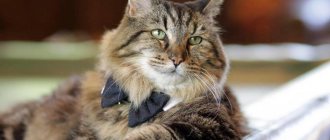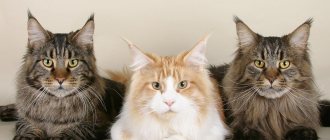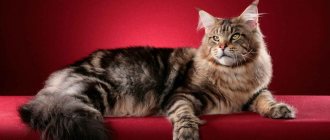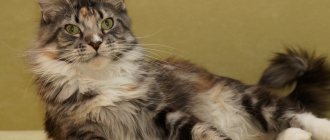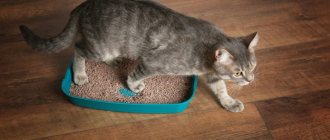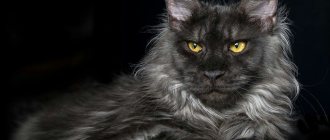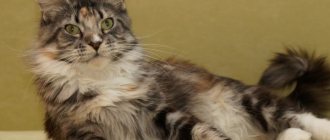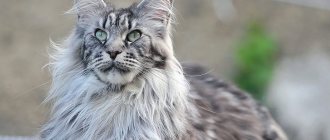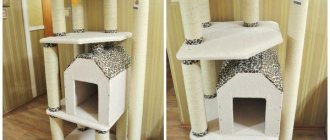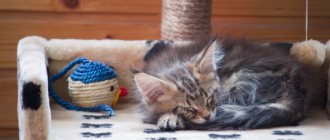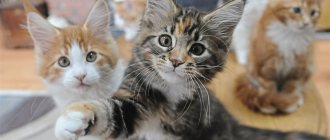A Maine Coon kitten is an amazing combination of impressive appearance (the largest among domestic cats) and a friendly disposition, regal bearing and playfulness, the image of a hunter and the disposition of a homebody. All these qualities appear at a very early age. You need to choose a kitten carefully, knowing exactly for what purpose the animal is being purchased. Caring for a Maine Coon is not very difficult, and the return - love and devotion to the owner - lasts a lifetime.
Tips for choosing
Meikoons are especially loved for their impressive size: cats reach up to 8 and even 10 kilograms. Cats are smaller. Like any other animals, Maine Coon kittens differ from each other in character, breed quality, and color. The most important thing is to choose an honest breeder and correctly identify the breed, without accidentally buying a mixed breed. Maine Coon is a native breed; they are not crossed with other species, which means that purebred kittens are expensive and are of interest to scammers.
If an animal is purchased for exhibitions, then purebredness is one of the most important qualities; a cat will simply be disqualified for being a crossbreed.
How to proceed when choosing a kitten?
- Read articles and books about the breed, visit cat shows, chat with owners and cattery owners. The larger the exhibition, the better the quality of the animals.
- The best thing is to study the breed standard according to felinological systems: TICA, WCF, CFA.
- Immediately give up the idea of buying a Maine Coon at the market or from someone else.
- Compare the cost of kittens: real Maine Coons cannot be cheap.
- You should definitely visit the nursery where the cats live and are raised and take a closer look at them.
- Look not at the color of the coat, but at its quality: a purebred Maine Coon in any color looks luxurious, its coat is silky, and grows densely.
- It is necessary to independently check the kitten for the absence of diseases, carefully examine it: there should be no discharge from the eyes and nose, the fur is smooth and silky, the kitten is playful.
It is recommended to buy a kitten at the age of three to three and a half months.
Distinctive features for a Maine Coon kitten: a “box” muzzle, tufts on the ears, a long tail.
Preparing a new home
Before bringing the kitten to its new home, you need to purchase everything you need:
- two bowls (one for food, one for water);
- scratching post;
- toilet and filler for it;
- a basket where the kitten can sleep;
- several toys.
This is a small miracle that will bring so much joy and positive emotions to every home.
It is preferable to buy dishes made of ceramics or earthenware, plastic sometimes causes allergies in cats. It is recommended to place the bowls nearby on the kitchen floor. One bowl will contain dry food, the other will contain clean water. It is advisable to place the bowls on a tray - this will make it easier to keep the kitchen clean, because kittens love to throw food around and spill water.
Usually there is no need to accustom the kitten to the litter box - by the time of sale it is already trained to do so. But the pet must be “introduced” to its toilet, since it is unlikely that it will find it on its own. The tray should be in a secluded, quiet place - nothing should scare the kitten or prevent it from doing its business.
Therefore, there is no need to place the cat litter somewhere in the hallway - the best place for it is the bathroom.
So, what three wishes should I make?
The basket should be placed in a place where the kitten will not be disturbed by anyone. It is, of course, advisable to accustom him to a specific sleeping place, but as a rule, cats choose where to sleep themselves.
It is better to install the scratching post near the wall. If it is poorly secured, a kitten (and even more so an adult cat) will easily knock it over. It is worth considering that Maine Coons are active and playful, so they need a play area, as well as a cat house.
Pet stores sell special play complexes for representatives of this particular breed - when creating them, the features of the anatomy and behavior of Maine Coons are taken into account. They love to climb up and watch everything that happens around them. If it is impossible to buy a gaming complex, you need to at least install several horizontal platforms at different heights. But this is unlikely if there was an opportunity to buy a Maine Coon - the price of a kitten is from 20,000 rubles.
Maine Coon kittens are very cute and active
Nurseries
Since Maine Coons are a show-class breed, their breeders are very attentive to where the kittens go, how they plan to keep them and in what capacity - for breeding, for exhibitions, for themselves.
You can find a cattery through a cat club, on the Internet, or at exhibitions.
You can wait for the kittens to arrive by booking them in advance. Catteries usually have their own Internet - a resource where information about all cats, cats, matings, exhibitions, and connections with foreign breeders is indicated. Professional breeders are interested in acquiring new animals every two to three years.
If the same animals constantly mate with each other, and there is no influx of new blood, it means that the owner makes money from breeding and selling, and he is not interested in improving the quality of the breed. A professional breeder will definitely invite the future buyer to the nursery, show all the animals, and help with choosing a kitten. If the weight of the male cat has been declared, you can ask for a control weighing - this is a normal procedure.
Before purchasing a kitten, you must find out whether the nursery is registered in the felinological system; this is a guarantee of purebred animals.
There are nurseries in apartments and outside the city. Even if it is located far from the city, it is better to visit it. When purchasing, an agreement will be concluded between the buyer and the seller on how the animal is planned to be used, how it can and cannot be crossed, and how the matings will take place. Nurseries provide all documents for kittens.
Popular Maine Coon kennels
In cat clubs, on Internet sites, and at cat shows you can get information about reliable catteries with a good reputation.
Nurseries create their own websites where you can not only get complete information about Maine Coons, find out information on keeping and caring for kittens, but also look at photographs of Maine Coons for sale and their parents.
Trusted nurseries where you can buy purebred Maine Coons of the “show” and “breed” classes, vaccinated, with all the required documents.
- “Absolute effect”, Moscow, website https://cooneko.com/index.html
- “Gulliver’s Country”, Ivanovo, website https://gulliver-coon.ru/pitomnik_maine_coon.html
- “Wild Beauty”, Moscow, website https://wildbeauty.ru
- "Chelgan", Chelyabinsk, website https://chelgan.ru
- AlmazCoon" Ekaterinburg, website: www.AlmazCoon.ru
- “Volga Pride”, Saratov https://www.saratov-coon.ru
Raccoon cats of the Maine Coon breed are good-natured, affectionate, but unobtrusive animals, devotedly attached to their owner. An active Maine kitten, although it can be mischievous, will become a favorite of the whole family from the first days. He gets along well with children and enjoys participating in all games.
Price
The price for a kitten of this breed depends on its status . There are three groups of animals that differ in cost:
- Show class.
- Brit class.
- Pet class.
The first category is animals intended for participation in exhibitions.
They cost more than all the others. The price can reach 100 thousand rubles.
The future owner of a Maine Coon pays this amount for a quality animal that meets the breed standards.
It has a purebred pedigree and will be able to exhibit and receive awards. It is used for mating.
The second group are female kittens suitable for breeding. They can produce show class offspring. They cost 30-35 thousand rubles. These cats have slight deviations from the standards, for example, too long or short hair, incorrect color or eye color. This does not affect their ability to exhibit and receive awards at shows.
The third group is exclusively pets for the home . They are the cheapest - 15-20 thousand rubles. They have many deviations from the breed standard and therefore cannot participate in exhibitions. They will not be used for mating either. But they possess all the other advantages of the breed - appearance, character - and therefore will become wonderful pets.
What else affects the price?
- The most expensive will be a kitten under 4 months of age.
- Cats are more expensive than cats.
- Unusual colors are more expensive.
- Mental abilities of the breed.
The intelligence of Maine Coons is absolutely consistent with their appearance and size.
These cats are considered real philosophers.
They think well, learn easily, and are capable of contemplation.
Their actions are logical, they are able to perform conscious actions (the same qualities are attributed to some types of dogs, for example, border collies and Labradors). Maine Coons have a very good memory, they can remember many words and commands.
They are well versed in intonation, distinguish human speech, its nuances, gestures and even understand glances. Maine Coons are called thinkers because they are able to remain in a state of peace and observation for a long time. Cats are not isolated from kittens even in the first minutes of their birth. Male Maine Coons actively participate in the life of their offspring, in raising and playing with kittens.
How to distinguish it from an ordinary cat?
It is sometimes difficult for a non-professional to distinguish a purebred animal from a mongrel cat. What to pay attention to in this case, here are the characteristic features of the breed:
- Maine Coons are larger than regular kittens. On average, a newborn weighs 100-150 grams, and regular kittens weigh 80-100 grams.
- The Maine Coon kitten is more active and stronger than ordinary cats.
- By three months, an animal of this breed already weighs on average about 2 kilograms for girls and 2.5 for boys. Simple cats at this age weigh no more than one and a half kilograms.
- The coat is thicker and fluffier than that of ordinary kittens.
- The body is large, the head is massive.
- The tail is thick, the paws are impressive, sometimes even at a young age you can see tufts of hair between the toes - a characteristic feature of Maine Coons.
- A purebred kitten has at least 4 generations of ancestors in its pedigree.
Below are photos of purebred kittens.
Amazing baby
The popularity of the Maine Coon breed was brought by an unusual kitten with a human face. A two-month-old cat named Valkyrie has attracted the attention of users all over the Internet. The owners posted a video and photographs online showing a face that is surprisingly human-like. “It’s as if a person was imprisoned in a cat’s body,” this is how they spoke about Valkyrie. The video received over a million views, going viral and becoming memes. The unusual color of the Valkyrie - “black smoke” - added even more mystery to this cat.
Popular colors
The breed standard recognizes all colors except chocolate, brown, lilac and fawn. The most popular color of the Maine Coon is the red tabby tabby. This is a bright red animal with a clear pattern that looks like a marble pattern.
“Tabby” (brindle) implies the presence of stripes on the body.
Black tabby and black tabby are also popular colors among Maine Coons. Smoke colors (white root and colored tip) are also very common.
The rarest and most expensive Maine Coon colors
Each breed has rare colors that are not often seen. Maine Coons are no exception. This breed has its own rare shades:
- Brown with spots. These kittens have a color similar to autumn foliage.
- Creamy blue. Looks like tortoiseshell with rare pastel shades.
- Chintz. This is a unique coloring for coons. The base is red, diluted with black tones with white splashes.
- Watered down chintz. There are cream-colored spots on a white background, and blue colors have a solid coloring.
- Spotted with white spots.
Such colors are not typical for coons and are rare.
Smoky
Such cats can be black or blue. The intensity of the haze determines the subspecies:
| Name | Description |
| Chinchilla | Only the tip of the hair is pigmented |
| Shaded | color has a quarter of the hair |
| Smoke | Only the root of the hair is colored white, the main part has black or blue pigments |
| True smoke | Half of the hair has pigmentation |
| Silver | the hair is white at the root, the rest is light silver |
| Cream | at birth, the coat is uniform in color, but gradually becomes unevenly pigmented |
| Classic wild | brindle, marbled black, spotted |
Smoky cats are characterized by white roots. Gray is usually found in monochromatic animals.
Chocolate
The wool is colored brown, warm, rich. The presence of inclusions of other shades or patterns is not allowed. The hairs have an even distribution of pigment. Unlike red tones, it is darker and deeper. Quite rare in breeding. The paw pads and nose also have brown tones.
Classic wild
This color suggests the presence of a pattern on the animal's fur. They can be of different types:
- brindle;
- marble black;
- spotted.
These are the main colors of coons that were common among their wild ancestors.
Peach
These cats have similar features to their cream counterparts. These can be yellow, orange shades characteristic of tabby coons.
Black
Black monochromatic coloring is extremely rare for this breed.
Each black coon has a different color depth and saturation, so it is impossible to find two identical black cats. Usually, this color hides the pattern on the coat. In small kittens it can be difficult to see, but as they grow older it is completely hidden. The cat becomes completely monochrome. An animal with black fur looks regal, luxurious, reminiscent of a majestic panther in appearance.
Black and white
Cats with this coloration have different proportions of these colors:
- Black with white spots. There are several small spots of white on the fur.
- White medallion. A white spot is located on the chest of the animal, reminiscent of decoration.
- White gloves. The cat has black and only white paws of the animal.
- White tuxedo. There is a white shirtfront on the neck, and the paws are also white.
- Bicolor. Black and white in a 1/1 ratio.
- Harlequin. The color is predominantly white with a few black spots.
- Wang. The head and tail are painted black. The rest of the body is white.
What is the danger of white color
White Coons have a predisposition to complete deafness.
It is found in this color much more often than in animals with a different shade of fur. However, there is no need to be upset by this fact. Deaf individuals feel great.
They live well in the house, and are oriented to the area no worse than healthy ones. Their hearing loss is compensated by vision and a keen sense of smell. People who do not know about cat deafness will not guess about it.
Cream
This shade is obtained by lightening the red. The animals are colored in shades similar to raw ginger. When crossing, individuals with genetically weakly expressed pigment in the pedigree are preferred. However, theoretically, even Black Solid Maine Coons can produce cream-colored offspring.
Height and weight by month
Newborn kittens weigh up to 120 grams; by the end of the first month of life, kittens weigh up to 600 grams, males - up to 800.
By the end of the second month, females weigh about 1.3 kg, males - up to 1.5 kg.
At 3 months, kittens usually double their size: females - up to 2.4 kg, males - up to 3.6 kg.
At 4 months, girls weigh up to 3.6 kg, boys - up to 3.9 kg. By six months, the kitten’s growth slows down, females reach from 2.8 to 4 kg, males from 3 to 4.5 kg. By 8 months, the Maine Coon adds about 1.5 kg to its weight. At 9 months, cats weigh up to 6 kg, males - up to 7 kg. At 10-11 months, the weight of girls is up to 7 kg, boys - up to 7.5 kg. By the age of one year, kittens can reach 8 - 9 kg.
Changing teeth
Kittens' teeth change quite painfully and unpleasantly for others - the animal begins to gnaw on everything and experiences discomfort. This usually occurs at 6 months, but can happen later, at 9 months. At this age, baby and permanent teeth are adjacent. Just like in humans, teeth first become loose and then fall out. Baby teeth need to be removed.
It is necessary to inspect the animal’s gums while changing teeth. If ulcers and suppuration appear, you need to show your pet to a veterinarian.
Remedies that relieve pain when changing teeth:
- Sea buckthorn oil.
- A solution of oak or chamomile bark.
- Yarrow solution.
For purebred animals, the process of the appearance of new teeth is very important: at this moment, a bite is formed, one of the breed standards. If it is violated, the cat will lose its exhibition qualities. Therefore, it is important not to leave your pet to its own devices during this period, but to monitor how the teeth are changing and, if there is any problem, go to the doctor.
Care for eyes, ears, teeth and claws
From time to time, kittens may develop crusts in the corners of their eyes - there is no need to be afraid of this, because people’s eyes also sometimes turn sour after sleep.
These crusts can be removed with a cotton swab dipped in boiled water (it is better to buy a special product at the pharmacy), swiping from the outer corner of the eye to the inner one. But if the discharge appears frequently and is heavy, you should contact your veterinarian.
Little fluffy will happily make some noise at home
The ears should be examined regularly, at least once a week. Healthy ears are pink, clean, without discharge or crusts. If your kitten begins to scratch its ears frequently and intensively, you should contact your veterinarian. This should also be done if redness and discharge are detected.
The presence of a small amount of sulfur is acceptable - it can be removed with a cotton swab dipped in a special solution. The gums should be pinkish, without red edges along the teeth line. Bad breath may indicate the presence of the disease.
Particular attention should be paid to the teeth if the pet eats soft food. At the age of about 4 months, kittens' teeth change.
The undeniable advantage of the Maine Coon is its peaceful and flexible character.
Maine Coons have large claws, so they have to be trimmed regularly.
It is very important not to damage the blood vessels - the blood will flow for a long time, and after that the pet will limp for some time. The claws need to be trimmed only across, having carefully examined them before doing so - the blood vessels are quite clearly visible.
There must be a scratching post in the house - it will save the furniture and increase the length of the period between trimming the claws.
Feeding
In the first months of life, kittens need milk in large quantities; the mixture can be purchased at pet stores.
Goat milk is allowed. In the first month, the kitten should eat about six times a day, in small portions.
It is better to ask the cattery what kind of food the cats eat and stick to that diet. Grown-up kittens are fed meat and vegetables.
Animals under 6 months of age need to be fed four times a day. The diet includes vegetables, cottage cheese and whey.
Adult cats - from one year old - are fed with specialized food:
- "Royal Canin" for Maine Coons.
- "Bosch Sanabelle Grande" for large breeds.
Vitamins
The best set of vitamins for cats of this breed is found in fish oil, eggs, dairy products, and tomatoes. For healthy skin, give cabbage, liver, and yeast products. Vegetables and fruits will boost your cat's immunity. With the help of natural vitamins, you can balance your pet’s diet so that he gets the maximum benefit from his food.
But to maintain health, you also need special products that contain zinc, copper, manganese, and iron. Pet stores offer vitamin complexes with taurine. They improve vision and digestion. For good skin and coat condition, vitamin complexes with biotin are given. The animal also needs calcium, vitamin B6, A, B and D.
Vaccinations
The first vaccination is given at the age of two months. This is a complex against:
- Viral infections.
- Tracheitis.
- Chlamydia.
- Pailenkopenia.
To prevent the body from being overloaded with vaccines, a special vaccination schedule is prescribed. The first - up to a year.
It is necessary to vaccinate a kitten before three months and after eight months, since from 4 to 7 months, during the period of teeth change, the animal’s immunity will be weakened, and it does not need to be undermined by vaccines. Vaccinations are given only to healthy animals, before which an anthelmintic is given. 10 days before vaccination, the cat is treated against fleas and ticks. The second vaccination occurs along with the rabies vaccination. A doctor must administer the vaccine.
Where to buy a kitten
Where to buy a purebred Maine Coon so as not to make a mistake in choosing. There are several options:
- At the market where they sell a lot of animals and offer Maine kittens. As a rule, such children do not have documents. There is a high probability of purchasing either a mestizo or a simple handsome guy for a not very high cost.
- It is also dangerous to hope on message boards on the Internet that the dozens of offers posted will not turn out to be a hoax.
- On the Avito website, sometimes breeders post photos of real Maines, but you need to be well versed in the intricacies of the breed of these unique cats. You may come across scammers with fake passports and photos of kittens. Most often, sick coons with defects according to the standard are offered there for a lower price.
- On the websites of nurseries you can find detailed information about each kitten and its parents. But you need to familiarize yourself with the reputational reviews of animals previously purchased from these breeders. To be sure, they visit the nursery itself, get acquainted with the breeding parents of the selected Maine, and the conditions of its maintenance. They check the passport and the availability of information in it and about all descendants up to the 4th generation. What and when vaccinations were given? The owners of the cattery must have a certificate giving the right to breed Maine Coons.
- For those who decide to purchase a guaranteed purebred Maine Coon, you should visit cat shows. Where you can not only choose your favorite kitten, meet its breeding parents and owners - breeders, but also get advice and recommendations on the breed and purchasing rules from the exhibition organizers.
Attention! You shouldn’t buy a pet right away at an exhibition; you need to go to the nursery and there thoroughly inspect the animal, check the conditions of detention and the correctness of filling out the documents. Take a closer look at other lambing brothers, maybe there will be a Maine that you like based on the appearance and character of its behavior.
Breed cost
Maine Coons are one of the most popular cat breeds in Russia and other countries. Many are attracted to them by their uniquely huge appearance and amazing resemblance to a wild animal. They are called domesticated little lynxes. Maine prices across the country are very high: from 20 to 80 thousand.
Different prices are set and explained by distinctive factors:
- Depending on the condition of the animal itself, gender, boy or girl, and color, solid maines are popular.
- From the presence of a pedigree to the 4th generation and documents, awards from parents.
- Region of sale and prestige of the seller.
- From class, prepared, main: exhibition “show”; for breeding "breeding" and ordinary pets of the "Pet" class.
Vaccinations
Owners of Maine Coons should take care of timely vaccination within the recommended period, especially for kittens with an immature immune system that is not always able to resist infections.
To vaccinate your pet, you need to prepare:
- To reduce the risk of allergic reactions, 19 days before vaccination, the pet is dewormed and treated for fleas and ticks.
- The kitten is being examined by a veterinarian for a health check.
The first vaccination is given at 2 months according to the schedule, while the kitten is still living with the breeder. Follow-up treatment for tetanus is carried out at 3 months. At one year of age, your coon should be vaccinated and then every year for the rest of its life.
Nicknames for Maine Coon kittens
It is prohibited to vaccinate:
- when mains are less than 2 months old;
- The kitten is teething:
- cats are in heat:
- pregnant cats and during lactation;
- weakened coons after illness.
Attention! The vaccine is administered only by a doctor in a clinic setting, where there are all conditions for carrying out the procedure and storing the vaccine properly.
Education
On the one hand, Maine Coons are freedom-loving and independent and do not lend themselves to drill or “dog” training, on the other hand, they are very smart and trainable animals.
At an early age, the kitten is taught to use a litter tray and scratching post.
In further training, the method of prohibitions and rewards is used. Spanking, beating, or any physical punishment against these cats is excluded. Maine Coons are humane, they must know their owner as a source of affection. You can use a spray bottle of warm water to teach prohibitions.
When a cat scratches something that is not allowed or climbs onto a forbidden object, it is lightly sprayed with water, creating discomfort. You can use odors that are unpleasant for your pet, for example, citrus, by treating them, for example, with curtains that are torn or torn by a cat. You can train your Maine Coon using your favorite food, encouraging him to perform various actions, or through play.
The first days of a kitten in the house
When moving a kitten to a new home, you need to take into account the main points that the migrant will encounter in the first days. Owners are advised to gradually and persistently accustom their Maine to unusual conditions and procedures:
- In a large house, so that the baby does not get lost, let him get comfortable in one room for several days. They also place bowls with water, food and a scratching post with a litter tray. Introduce them to the pet.
- Family members in the house are introduced one by one. Everyone needs to caress the baby, talk to them, and play with them.
- The maine kitten is introduced to other animals in the house in the presence of the owner. By observing them, he controls and suppresses aggressive moods, and tries not to arouse jealousy between them.
- From the first day they begin raising a pet. They strictly, consistently and unswervingly instill in him what not to do in the house. For example: climbing on the table, riding on the curtains, using only a litter tray for the toilet, or other prohibitions typical of the routine in the house.
- It is impossible to switch the baby to another type of food in the first months. After adaptation to the new home, he is transferred to a different diet gradually, without causing irritation to the housing and communal services.
Tray training
From the first days in the house, the kitten should know the location of the litter box. To accustom a coon to the litter box, it is useful for the owner to take from the breeder in advance a bag of filler to which the pet is already accustomed. If a cat misbehaves or relieves itself in the wrong place, he is punished, but not physically, but in a stern voice by leading him to the litter box.
Important! Access to the litter box should always be free and the kitten should be familiarized with its permanent hiding place.
Care
The Maine Coon, like any pet, needs to be carefully looked after and monitored for the pet’s health. A set of simple steps for care:
- Vaccinate once a year against rabies, calcivirosis and other diseases.
- Treat for fleas and ticks.
- Brush about twice a week, more often during shedding periods. Bath several times a month.
- Examine your teeth and gums for tartar buildup or other problems. If necessary, see a veterinarian and add vitamins to the diet.
- Examine your eyes and wipe them daily with a clean piece of cotton wool. If discharge appears, wipe with a weak tea solution. If necessary, contact a specialist.
- Use spacious trays with filler, preferably wood. Keep them clean at all times.
- Communicate and play with the animal more often.
Grooming
Maine Coons have beautiful long hair, which brings a lot of trouble to the owners of these cats.
Kittens need daily brushing as they cannot groom their fur yet. Furminators or regular metal combs with long teeth are suitable for combing kittens' fur (they should not be sharp).
First, the wool is combed with a comb with rare teeth, then with frequent ones. Finally, the wool is brushed with a brush with natural bristles.
Daily brushing will help prevent the formation of tangles and also promote better coat growth. It is also advisable to brush adult animals every day, especially during shedding. They can also be cut.
The cat has a gorgeous red fur coat, gorgeous thick brushes and breathtaking green eyes.
There is no need to bathe cats often; they are clean animals. This should be done when necessary: if the wool is dirty or greasy.
For bathing, you need to purchase a special cat shampoo, preferably hypoallergenic (for example, Jerob, Espree). It also doesn’t hurt to have anti-flea shampoo at home, especially if the pet lives in a private home or other animals live with it.
When bathing, you need to make sure that water does not get into the ears. After bathing, the cat should be thoroughly dried and brushed.
